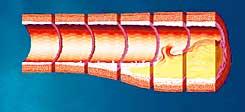It is a series of substances called corollas that slight changes in them allow treatments for completely different diseases

Innovative substances called corroles, recently developed at the Technion Faculty of Chemistry, have been found to be extremely effective in the treatment of various diseases. Slight synthetic changes allow one derivative to be used for the detection and elimination of cancer cells, and turn another derivative into a catalytic antioxidant that inhibits the development of arteriosclerosis. The sclerosis project is the result of a collaboration between the Faculty of Chemistry (doctoral student Adi Haber) and the Faculty of Medicine at the Technion, while the cancer project was made possible thanks to a collaboration between the Technion (senior researcher Dr. Atef Mahmid), the California Institute of Technology (Caltech) and the Cedars-Sinai Medical Center in Los Angeles.
For many years, the corroles were not thoroughly studied because their synthesis was very tedious (multi-step) and led to obtaining tiny amounts of material. The situation changed dramatically ten years ago following a breakthrough achieved by Professor Zeev Gross, from the Faculty of Chemistry at the Technion, whose group developed a method that enables the production of the quantities of material needed to conduct medical research. This development enabled an in-depth study of the chemistry of the corroles, which opened the door to the use of these materials in preclinical trials.
Collaboration between the research groups of Professor Zeev Gross and Professor Michael Aviram, from the Rappaport Faculty of Medicine at the Technion, an expert in the field of antioxidants from natural sources, led to the identification of iron-containing corolla as very effective in inhibiting atherosclerosis. In an article published in the international edition of the journal Angewandte Chemie, it is described how this substance inhibited the development of the sclerotic lesion in mice with a higher efficiency than that observed with the natural antioxidants, as well as that obtained with the most effective synthetic substances to date. This is possible thanks to the catalytic activity of the corroles, which breaks down the "free radicals" continuously, in contrast to the classic antioxidants that degrade over time.
In the collaboration between Professor Gross and Professors Harry Gray of Calcutta and Leli Medina-Kvah and Daniel Parkash of Cedars-Sinai Medical Center, corolla containing gallium was used instead of iron. The conjugation of this corrol to a protein with a distinct affinity for especially aggressive breast cancer cells enabled the targeting of the corrol to these tumors. In an article published in the journal Proceedings of the National Academy of Science, the researchers describe how they used the fluorescence of the gallium-corolla for non-invasive imaging of the cancerous tumor in mice. In addition, they found that the corolla shrunk the cancerous tumor at much lower concentrations than those required to obtain a similar result with the conventional drug against this type of cancer. The most common side effect of this drug, damage to the heart, was also avoided by using Gallium Corol.

3 תגובות
If the corolla gallium shrunk the tumor does that mean it is toxic?
There seems to be some mistake here.
The article is about arteriosclerosis and the picture shows a brain with multiple sclerosis.
These are two different diseases, unrelated to each other.
Arteriosclerosis is a disease that manifests itself in the gradual clogging of the arteries, while multiple sclerosis is a neurological disease, of disconnections between the brain and part of the nervous system.
Amazing, when is it expected to be marketed?